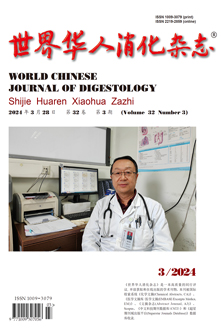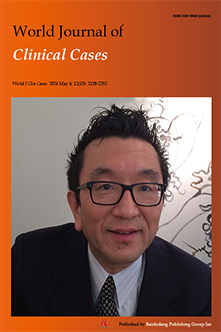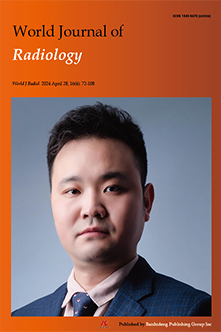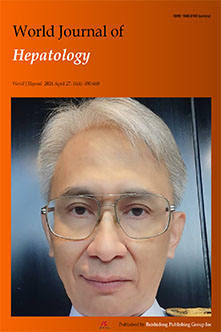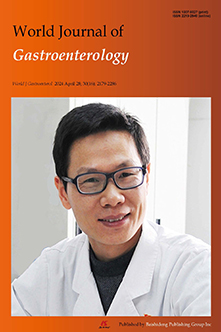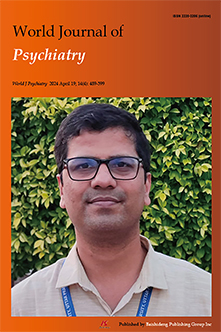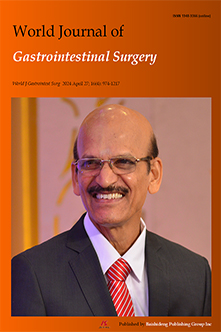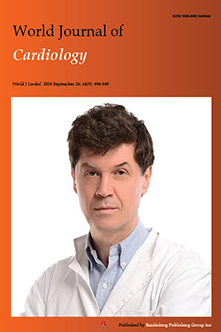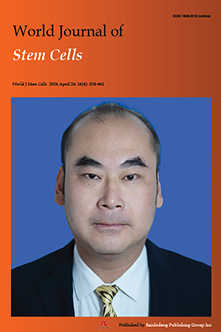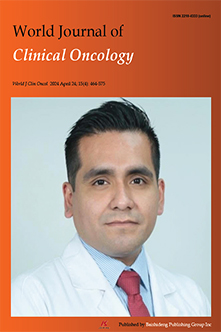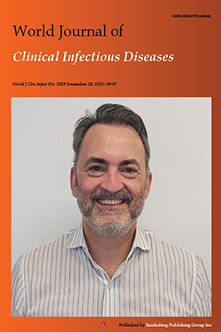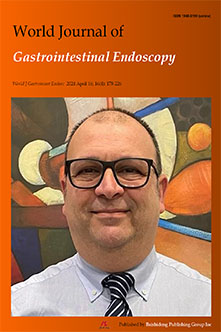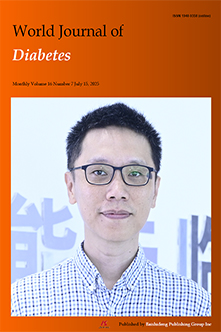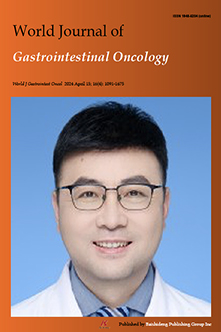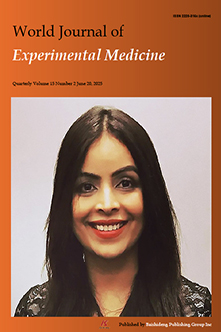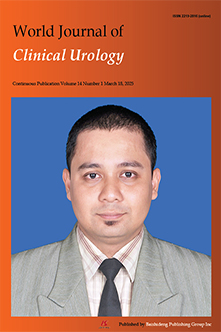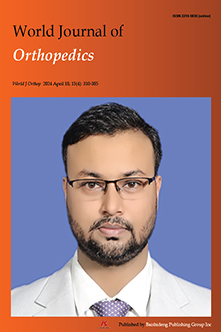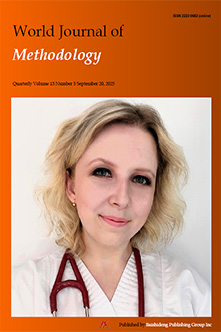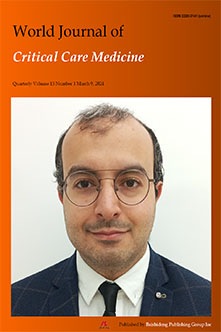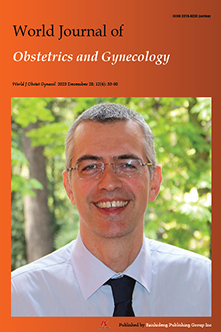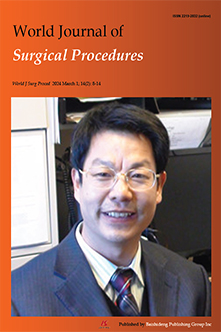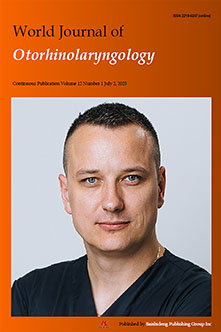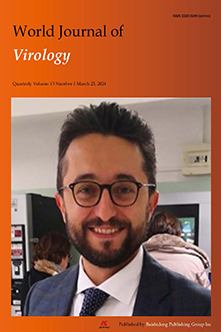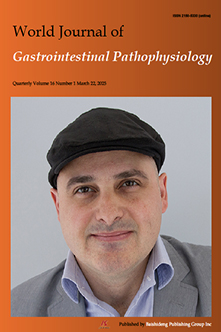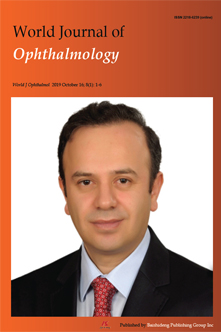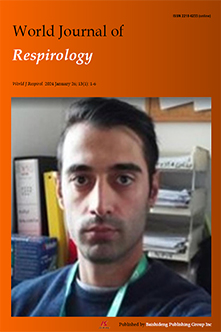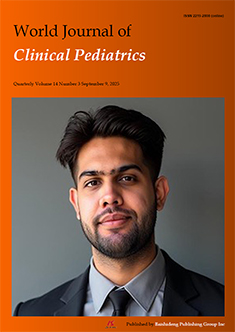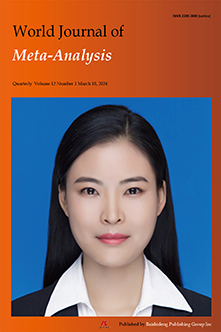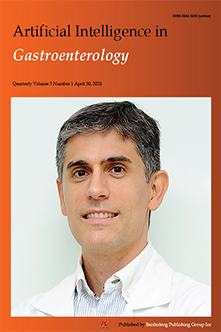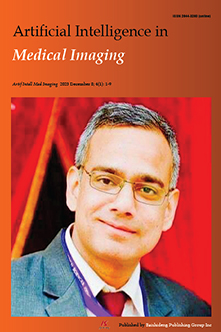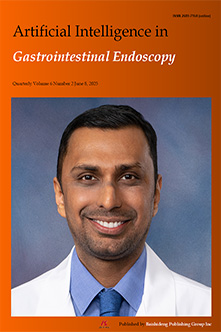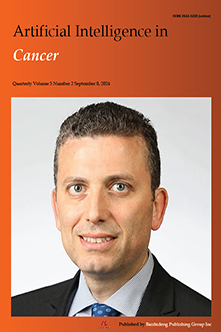Publisher Login
Manuscript Statistics
1
2
2025-08-28 | Browse: 1 | Download: 0
3
4
5
2025-08-28 | Browse: 1 | Download: 0
6
7
8
9
10
11
12
13
14
15
16
17
2025-08-27 | Browse: 23 | Download: 0
18
2025-08-27 | Browse: 23 | Download: 0
19
20
2025-08-27 | Browse: 25 | Download: 0
595 items Read more >>
1
"We wish we had had much more time for revision of the article, because the language editing company requires at least 5 days to review ..."
[Read more]
"We wish we had had much more time for revision of the article, because the language editing company requires at least 5 days to review the language and provide a certificate. These 5 days had to be included in the revision time. We were worried about not submitting on time and had to pay extra money to have a swift language check. Thank you. "
[Collapse]
Simsar M, Yuruk YY, Sahin O, Sahin H. Radiological insights into diverticulitis: Clinical manifestations, complications, and differential diagnosis. World J Radiol 2025; 17(8): 107463
2
"First and foremost, we extend our sincerest gratitude to the editorial team of your journal for their professionalism and efficient ..."
[Read more]
"First and foremost, we extend our sincerest gratitude to the editorial team of your journal for their professionalism and efficient collaboration throughout the review process, from initial submission to final publication. Their efforts have been instrumental in disseminating our academic work.We are particularly grateful to the anonymous reviewers for their constructive feedback. Their insightful critiques and rigorous suggestions have not only enhanced the academic rigor of this paper but also deepened our appreciation for the meticulous nature of scientific research.As researchers, we embrace scholarly criticism with an open mind. The methodological limitations and data interpretation issues identified during the review process have been addressed through additional experiments and comparative literature analysis. This constructive "review-improvement" cycle is fundamental to advancing the academic community. "
[Collapse]
Zhang RN, Cui JY, Zhao ZH, Li YT, Liu ZW, Zhang JY, Wei Q, Lu YM, Chen QP. Prevalence of sarcopenia in patients with surgical obstructive jaundice and its impact on clinical outcomes. World J Gastrointest Surg 2025; 17(8): 107209
3
"I would like to give my sincerely appreciation to the editors and work staffs for all your efforts during the process of my manuscript ..."
[Read more]
"I would like to give my sincerely appreciation to the editors and work staffs for all your efforts during the process of my manuscript publication. I am very satified with all the steps in the review and editing process, and hope publish more works with your jounral in the future. Thanks you very much. "
[Collapse]
Yang RH, Lin ZP, Dong T, Fan WX, Qin HD, Jiang GH, Dai HY. Magnetic resonance imaging-based radiomics signature for predicting preoperative staging of esophageal cancer. World J Radiol 2025; 17(8): 110307
4
"I am very satisfied with the process of publishing this paper. The external review was sent out very promptly, and the expert reviewers ..."
[Read more]
"I am very satisfied with the process of publishing this paper. The external review was sent out very promptly, and the expert reviewers provided professional revision suggestions, which was very important for my later writing. The article was also published quickly, greatly saving our time. Overall, I am very satisfied with the submission and publication of this paper. If given the opportunity in the future, I would still choose your journal. "
[Collapse]
Liu JM, Li Z, Qi LH, Chu BL, Deng ZX, Tang FY. Imaging features of appendiceal signet ring cell carcinoma with uterine implantation: A case report. World J Radiol 2025; 17(8): 110868
5
"We are happy with the submission. I hope that y the editor can provide us with additional invited papers. We look forward to working ..."
[Read more]
"We are happy with the submission. I hope that y the editor can provide us with additional invited papers. We look forward to working with BPG. The reviewing process needs work. It takes numerous months before reviewers are found. The system could be improved by slimlining the entire submission process. Other journals take 1-2 for complete publication. "
[Collapse]
Enaholo E, Okoye G, Musa M, Suleman A, Ojo O, Foti R, D’Esposito F, Giglio R, Tognetto D, Gagliano C, Zeppieri M. High-resolution optical coherence tomography for screening ocular surface tumors: Historical markers and future directions. World J Clin Cases 2025; 13(29): 108046
6
"I would like to express my sincere appreciation to the editorial team of the World Journal of Radiology for their professional and ..."
[Read more]
"I would like to express my sincere appreciation to the editorial team of the World Journal of Radiology for their professional and efficient handling of my manuscript. The peer review process was rigorous, constructive, and timely, providing valuable comments that significantly improved the overall quality and clarity of the work. The communication with the editorial office was smooth and courteous, and the publication process was transparent and efficient, ensuring a positive experience from submission to final acceptance. I am grateful for the opportunity to publish in this journal and commend the editors, reviewers, and staff for their dedication to maintaining high academic standards and supporting authors throughout the process. "
[Collapse]
Ren S, Qin B, Daniels MJ, Zeng L, Tian Y, Wang ZQ. Developing and validating a computed tomography radiomics strategy to predict lymph node metastasis in pancreatic cancer. World J Radiol 2025; 17(8): 109373
7
"Thank you very much for publication of this manuscript. I think period of peer review is very long. So, I'm very happy if period of ..."
[Read more]
"Thank you very much for publication of this manuscript. I think period of peer review is very long. So, I'm very happy if period of peer review would be be shorter. On the other hand, I don't have other comments. I try to submit more articles to this journal of other journal in this company. Thank you very much. "
[Collapse]
Usuda D, Furukawa D, Imaizumi R, Ono R, Kaneoka Y, Nakajima E, Sugawara Y, Shimizu R, Sakurai R, Matsubara S, Tanaka R, Suzuki M, Shimozawa S, Hotchi Y, Osugi I, Katou R, Ito S, Mishima K, Kondo A, Mizuno K, Takami H, Komatsu T, Nomura T, Sugita M. Purpureocillium lilacinum: A minireview. World J Clin Cases 2025; 13(29): 108582
8
"The editorial experience with the World Journal of Clinical Pediatrics was exceptionally smooth and professional. Communication from ..."
[Read more]
"The editorial experience with the World Journal of Clinical Pediatrics was exceptionally smooth and professional. Communication from the editorial office was timely and helpful, submission guidelines were clear, and the peer review process was constructive. We sincerely appreciate the efficiency, guidance, and support provided, ensuring a seamless submission to decision journey. "
[Collapse]
Omullo P, Nurani KM, Shahabi K, Emma O, Mutuku B. Congenital scoliosis with truncus arteriosus type 1 in a preterm neonate: A case report. World J Clin Pediatr 2025; 14(3): 106439
9
"The journal’s reputation for excellence is clearly reflected in your team’s dedication, and I truly appreciate the effort put into ..."
[Read more]
"The journal’s reputation for excellence is clearly reflected in your team’s dedication, and I truly appreciate the effort put into ensuring a smooth and successful publication. Thank you for your hard work and support—it has been a pleasure working with you. I look forward to future opportunities to contribute to your esteemed journal. "
[Collapse]
Zhou XL, Li Y, Xia W, Zheng YY, Wu AP. Advances in transcranial magnetic stimulation for psychological symptom management in Parkinson’s disease. World J Psychiatry 2025; 15(9): 108497
10
"I sincerely appreciate the seamless publication process of my article. From initial submission to final publication, every stage ..."
[Read more]
"I sincerely appreciate the seamless publication process of my article. From initial submission to final publication, every stage reflected remarkable efficiency and attention to detail. The peer-review process was both rigorous and timely, with constructive feedback that genuinely strengthened the paper. Your editorial team’s prompt responses to queries and transparent communication set a gold standard for academic publishing. The copyediting precision—particularly in standardizing references and refining technical terminology—demonstrated expertise I rarely encounter elsewhere. I look forward to collaborating with your journal next time. "
[Collapse]
Chen WY, Chen Q, Wang CC, Zhang CY, Chen SK, Meng ZQ, Han P, Dong S, Chen QW. Response rates, survival status and adverse events of placebo in randomized control trials for hepatocellular carcinoma: A meta-analysis. World J Hepatol 2025; 17(8): 108533
11
"My experience with the publishing process with Baishideng has been very intuitive and thorough. I am pleased with the level of ..."
[Read more]
"My experience with the publishing process with Baishideng has been very intuitive and thorough. I am pleased with the level of expertise that has gone into generating a quality publication. The only improvement would be for the communication and notification for replies could be made more accessible to the authors trying to publish. "
[Collapse]
Sabatose KW, Baker A, Kugler K, Delikat J, Jowers B, Kumar A, Aslam S, Buggs J, Machado-Denis C, Kemmer N, Dhanireddy K, Syed R. Patient factors in responders and non-responders treated with steroids for acute alcohol-associated hepatitis. World J Hepatol 2025; 17(8): 108677
12
"I am deeply honored to have the opportunity to collaborate with you. I would also like to express my sincere gratitude to all the ..."
[Read more]
"I am deeply honored to have the opportunity to collaborate with you. I would also like to express my sincere gratitude to all the reviewers and editors for their thorough review and thoughtful revisions of my work. Their contributions have significantly enhanced the quality of this piece and provided invaluable guidance for our future efforts. "
[Collapse]
Yan HH, Ding ZY, Wang LL, Zhong DD, Jin XF, Liu XC, Cai JT, Lu XL. Effects of early diet resumption on the incidence of complications following polypectomy: A randomized controlled trial. World J Gastrointest Surg 2025; 17(8): 108669
13
"We authors are thoroughly impressed with the peer review process and the prompt responsiveness demonstrated by your journal. The ..."
[Read more]
"We authors are thoroughly impressed with the peer review process and the prompt responsiveness demonstrated by your journal. The meticulous attention to detail clearly reflects your publication’s strength. We extend our best wishes for the journal’s continued success and a steadily rising Impact Factor. We will be recommending more colleagues to submit their work to your esteemed publication. "
[Collapse]
Gao XX, Xu XX, Chen P, He TX, Du CZ, Zhou Q, Zhou GF, Guo XW, Peng JR, Li HT. Rare complete replacement-type left hepatic artery originating from the left gastric artery: A case report. World J Hepatol 2025; 17(8): 110413
14
"Dear Editor, We would like to sincerely thank you for giving us the opportunity to publish our article in the World Journal of ..."
[Read more]
"Dear Editor, We would like to sincerely thank you for giving us the opportunity to publish our article in the World Journal of Hepatology. Your professional support, as well as the assistance of your editorial team, has been both fair and highly valuable throughout the entire review and production process. We also extend our deep gratitude to the reviewers, whose constructive comments and insightful suggestions have significantly enhanced the quality and clarity of our manuscript. Their critical input helped us strengthen the scientific contribution of our work. It has been a privilege to collaborate with your esteemed journal, and we sincerely hope that this fruitful cooperation will continue in the future. Sincerely, Enver Zerem, Corresponding Author on behalf of all authors "
[Collapse]
Zerem E, Kunosic S, Kurtcehajic A, Zerem D, Zerem O. Bile acids in metabolic dysfunction-associated steatotic liver disease. World J Hepatol 2025; 17(8): 108606
15
"I am satisfied with the overall peer-review process, including the presentation of tables, figures, and typesetting. However, I believe ..."
[Read more]
"I am satisfied with the overall peer-review process, including the presentation of tables, figures, and typesetting. However, I believe there is room for improvement in the timeline to publication. In the case of this review article, the process took approximately 150 days, which I personally feel is longer than ideal. A shorter turnaround time would enhance the author experience and help maintain the relevance of the research. "
[Collapse]
Singla N, Shantan V, Saraswat A, Singh AP. Advances in portal pressure measurement: Endoscopic techniques, challenges, and implications for liver transplantation. World J Hepatol 2025; 17(8): 107679
16
"We are grateful to the editors and reviewers for their insightful comments, which have significantly improved this manuscript. This ..."
[Read more]
"We are grateful to the editors and reviewers for their insightful comments, which have significantly improved this manuscript. This case report highlights the importance of considering ectopic adrenal adenoma in the differential diagnosis of hepatic masses, particularly when conventional imaging features overlap with hepatocellular carcinoma. Our experience underscores the need for a comprehensive diagnostic approach—integrating clinical history, multi-modality imaging, hormonal evaluations, and histopathological confirmation—to avoid misdiagnosis of rare ectopic tumors. We hope this report raises awareness among clinicians about the potential pitfalls in diagnosing hepatic lesions and encourages a broader differential diagnosis that includes embryologically derived ectopic tissues. Special thanks to our institutional support and colleagues who contributed to the management of this patient. We believe this case will serve as a valuable reference for improving diagnostic accuracy in similar clinical scenarios. "
[Collapse]
Qin MQ, Zhao YP, Xie JP. Ectopic adrenal gland in the liver leading to a misdiagnosis of hepatocellular carcinoma: A case report. World J Hepatol 2025; 17(8): 108443
17
"Thank you to the editors and reviewers for your diligent work and professional insights. The rigorous peer-review process has been ..."
[Read more]
"Thank you to the editors and reviewers for your diligent work and professional insights. The rigorous peer-review process has been highly beneficial and greatly contributed to the quality of the manuscript. The publication process was clear and efficient, and I am very pleased with the final outcome. I wish the journal continued success and look forward to the opportunity to submit to your esteemed publication again in the future. "
[Collapse]
Gao DJ, Zeng T, Chong YT, Li XH. Copper and hepatic lipid dysregulation: Mechanisms and implications. World J Hepatol 2025; 17(8): 107803
18
"My experience with the evaluation system of World Journal of Hepatology has been highly positive. The peer-review process was rigorous ..."
[Read more]
"My experience with the evaluation system of World Journal of Hepatology has been highly positive. The peer-review process was rigorous yet constructive, with comments that were detailed, precise, and very helpful in improving the quality of the manuscript. The editorial workflow was efficient and transparent, and communication with the editorial office was always clear and timely. I particularly value the openness of the system, which allows access to peer-review reports and author responses, thereby reinforcing the credibility and scientific integrity of the journal. Overall, I consider the evaluation process to be exemplary and a strong contribution to maintaining high editorial and academic standards. "
[Collapse]
Pestalardo ML, Bevilacqua CS, Amante MF. Vitamin A toxicity and hepatic pathology: A comprehensive review. World J Hepatol 2025; 17(8): 107738
19
"Dear Chief Editor and Esteemed Reviewers, Greetings of the day. Thank you so very much for publishing our manuscript in your ..."
[Read more]
"Dear Chief Editor and Esteemed Reviewers, Greetings of the day. Thank you so very much for publishing our manuscript in your prestigious PubMed Journal. We are very much obliged for the great efforts done by the reviewers, editors and the publication team. Their actions had greatly improved the overall scientific and academic quality of our manuscript upto highest international standards. Hopefully this unique manuscript will garner lots of citation in the scientific community. Thanks for the opportunity. Best Regards, Dr . Arvind Kumar Morya MS(Gold Medalist) MNAMS Additional Professor & Unit-I Head Cataract, Glaucoma, Refractive, Squint Paediatric Ophthalmology and Medical Retina Services Associate Editor UKJOS, National Advisor IJO,GJCSRO Editorial Board Member IJOVS, WJCC, EC-Ophthalmology, DOS Times, Journal of HOS. Reviewer Elsevier, AIMDR and IJO Clinical Trial Expert Panel - CDSCO & Ministry of Health and Family Welfare Convenor - AIOS Adverse Event Committee Department of Ophthalmology All India Institute of Medical Sciences, Bibinagar Hyderabad, Telangana -508126 INDIA +91-8003996598 "
[Collapse]
Parmar UPS, Morya AK, Gupta PC, Arora A, Verma N. Role of artificial intelligence-based ocular biomarkers in hepatobiliary diseases: A scoping review. World J Hepatol 2025; 17(8): 109801
20
"We wish to extend our sincere appreciation for the exceptionally efficient and rigorous peer-review process. The swift yet meticulous ..."
[Read more]
"We wish to extend our sincere appreciation for the exceptionally efficient and rigorous peer-review process. The swift yet meticulous feedback provided by your reviewers and editors is truly commendable. This dedication not only upholds the highest scholarly standards but also significantly accelerates the dissemination of valuable research, making the publication journey a highly positive and rewarding experience for authors. Thank you for your outstanding commitment to excellence. "
[Collapse]
Mei SB, Liu J, Wang Y, Hu P, Cao Q. Inferior mesenteric arteriovenous fistula: Three case reports. World J Gastrointest Surg 2025; 17(8): 108656
19401 items Read more >>
1
"Authors have present case in learning mode for readers.
IO in pregnancy is always challenging to manage as reflected in this ..."
[Read more]
"Authors have present case in learning mode for readers.
IO in pregnancy is always challenging to manage as reflected in this case.
Subtle Clinical manifestations in this IO in pregnancy often overlook these as masked by pregnancy symptoms
Adhesion obstruction aggravating during pregnancy having hormonal role is debatable
Gravid uterus compression may be precipitaing factor.
Conservative management is choice unless conditions desperately demand surgical intervention.
"
[Collapse]
Omullo FP, Anyango OS, Mutua BM, Odoyo MO, Gogo HM, Obung'a VO. Fatal small bowel perforation complicating intestinal obstruction in pregnancy: A case report. World J Clin Cases 2025; 13(29): 109406
2
" The manuscript is written well. Its structure is appropriate for this type of article. Ethical approval form meets the requirements. ..."
[Read more]
" The manuscript is written well. Its structure is appropriate for this type of article. Ethical approval form meets the requirements. Methods are appropriate and effective. Results are appropriate of methods and are authentic. Tables and biostatistics data are perfect. The references are adequate of topic. Language of article is satisfied."
[Collapse]
Omullo FP, Anyango OS, Mutua BM, Odoyo MO, Gogo HM, Obung'a VO. Fatal small bowel perforation complicating intestinal obstruction in pregnancy: A case report. World J Clin Cases 2025; 13(29): 109406
3
"Estrogen has receptors for (ERα) and (ERβ), each of which is distributed in different tissues and has diverse physiological effects. ..."
[Read more]
"Estrogen has receptors for (ERα) and (ERβ), each of which is distributed in different tissues and has diverse physiological effects. ERα plays an important role in the reproductive organs, bones, and mammary glands, while ERβ functions in skeletal muscles, the nervous system, and the immune system. The authors' data suggests that in liver cancer, ERα is involved in the growth of liver cancer, while the expression of ERβ may control the development and progression of liver cancer. This is very interesting data."
[Collapse]
Groover S, Addison S, Nicks S, Mwangi M, Brooks A, Kaul A, Kaul R. Sex based relative expression of estrogen receptors and tumor necrosis factor-alpha in liver affects hepatitis C virus viral pathogenesis. World J Gastroenterol 2025; 31(32): 104277
4
"This is a well- written and presented rarely case report about Invasive inflammatory fibrotic polyp of the duodenum.This manuscript ..."
[Read more]
"This is a well- written and presented rarely case report about Invasive inflammatory fibrotic polyp of the duodenum.This manuscript gives additional new knowledge to the existing literature. This interesting and rare case report has certain guiding significance for clinicians. I think that this manuscript is suitable and worth to publication."
[Collapse]
Zhang FM, Ning LG, Wang JJ, Zhu HT, Feng MB, Chen HT. Invasive inflammatory fibrotic polyp of the duodenum: A case report. World J Gastrointest Surg 2025; 17(8): 107558
5
"The ethical approval meets requirements. The data obtained from the CCORD/ACCORDION trials (ClinicalTrials.gov identifier: ..."
[Read more]
"The ethical approval meets requirements. The data obtained from the CCORD/ACCORDION trials (ClinicalTrials.gov identifier: NCT00000620). The methods are effective and can be repeated by fellow researchers. The inclusion and exclusion criteria are clear. The authors conducted a study of 10251 participants aged 40-79 years diagnosed T2DM who were followed up for nearly 10 years to investigate the association of METS-IR with incidence of adverse cardiovascular (CVD) events. The main results and tables of this study are authentic, reliable and validate the initial hypothesis. By using the Cox proportional hazards models, restricted cubic spline, stratified subgroup analyses, and C-statistic analyses, the positive association of METS-IR with incidence of adverse CVD events and enhanced risk assessment and prediction of CVD events by adding METS-IR were observed. The statistical analyses were correct. The graphs and figures were constructed and annotated well. One suggestion and confusion should be noted. (1) Suggestion: MACEs, CVD mortality and other outcomes should not be presented in the Table 1. (2) Confusion: In the Data collection and outcomes section, the MACEs was defined as a composite of cardiovascular mortality, nonfatal myocardial infarction (MI), and non-fatal stroke. So, I assumed that the number of MACEs should be equal to the sum of CVD mortality, non-fatal MI, and non-fatal stroke. However, in the Table 1, the number of MACEs was less than the sum of them. The authors should explain this. Authors have cited key references to support the pathophysiological mechanisms and prior epidemiological relationship, as well as the recent references. The language is generally clear, concise, and logically structed. One mistake should be written. The sentence “Further studies have indicated that biological aging the effects of METS-IR on all-cause and CVD mortality” is not fluent."
[Collapse]
Xin Y, Peng NL, Xin CY, Liao JR, Hu XQ, Dong YH, Zhang XY. Metabolic score for insulin resistance is associated with adverse cardiovascular events in patients with type 2 diabetes. World J Diabetes 2025; 16(8): 108671
6
"This review explores the possible role of SARS-CoV-2 infection in the development of malignant neoplasms of the gastrointestinal ..."
[Read more]
"This review explores the possible role of SARS-CoV-2 infection in the development of malignant neoplasms of the gastrointestinal system. The proposed mechanisms, as is the case in almost all types of malignant neoplasms, are related to chronic inflammatory processes, disturbances in cellular homeostasis, and possibly the integration of the virus into host cells. The significance of these observations is obvious, since if they are proven to be true, measures will need to be taken to systematically monitor patients who have contracted SARS-CoV-2.
In their very interesting review, the authors also present some thoughts on the reliability of published studies linking SARS-CoV-2 infection with the development of digestive cancer. I would like to add one more doubt. Medical students learn that cancer is a multistage process with multiple causes on the one hand and a time-consuming process on the other. I am struck by the fact that the scientific community almost immediately adopts clinical or experimental evidence of carcinogenesis from a particular cause despite the generally accepted views I mentioned above. In any case, this subject is an extremely interesting subject worth consideration. I believe that in the near future, a number of epidemiological and basic research studies should be conducted to better understand whether this virus is really oncogenic and to further clarify possible mechanisms of carcinogenesis."
[Collapse]
Miteva DG, Gulinac M, Peruhova M, Velikova T. Exploring the oncogenic potential of SARS-CoV-2 in the gastrointestinal tract. World J Gastroenterol 2025; 31(31): 105665
7
"Good article on an important topic. Well researched. Will act as a reference point for future articles on this subject. Use of ..."
[Read more]
"Good article on an important topic. Well researched. Will act as a reference point for future articles on this subject. Use of Artificial intelligence to improve patient outcomes is the future. Author has taken good reference points and has written an unbiased article. More such articles and editorials are welcome."
[Collapse]
Tasci B, Dogan S, Tuncer T. Artificial intelligence in gastrointestinal surgery: A systematic review. World J Gastrointest Surg 2025; 17(8): 109463
8
"An interesting article on tissue engineering with a good set of modern methods incl. immunochemistry and valuable data on ligament ..."
[Read more]
"An interesting article on tissue engineering with a good set of modern methods incl. immunochemistry and valuable data on ligament regeneration using MSC seeded fibrous scaffolds.
1 Ethics: The ethical approval form provided by the author meets the requirements.
2 Methods: The experimental method effective and can be repeated.
3 Results: The results are true and authentic.
4 Figures and tables: The authors provide perfect tables, line charts and/or graphs.
5 Biostatistics: The authors provide perfect biostatistics data.
6 References: The authors scientifically and reasonably cite the latest references which are important in this field.
7 Language: The language in article correctly, clearly and concisely expresses the information? "
[Collapse]
Yang CW, Zhang YQ, Chang H, Gao R, Chen D, Yao H. Aligned nanofiber scaffolds combined with cyclic stretch facilitate mesenchymal stem cell differentiation for ligament engineering. World J Stem Cells 2025; 17(8): 107124
9
"A good review with general information about MSCs and artificial intelligence and specific information about the application of ..."
[Read more]
"A good review with general information about MSCs and artificial intelligence and specific information about the application of artificial intelligence in MSCs therapy.
1 Ethics: The ethical approval form provided by the author meets the requirements.
2 Methods: The experimental method effective and can be repeated.
3 Results: The results are true and authentic.
4 Figures and tables: The authors provide perfect tables, line charts and/or graphs.
5 Biostatistics: The authors provide perfect biostatistics data.
6 References: The authors scientifically and reasonably cite the latest references which are important in this field.
7 Language: The language in article correctly, clearly and concisely expresses the information?
"
[Collapse]
Choudhery MS, Arif T, Mahmood R. Applications of artificial intelligence in stem cell therapy. World J Stem Cells 2025; 17(8): 106086
10
"A good informative review with valuable general information in the Introduction and 2 first sections and specific information on ..."
[Read more]
"A good informative review with valuable general information in the Introduction and 2 first sections and specific information on clinical cases about MSC therapy for lupus nephritis.
Liu L, Behera TR, Wang QJ, Shen QQ. Advances in mesenchymal stem cell therapy for lupus nephritis. World J Stem Cells 2025; 17(8): 104930 [DOI: 10.4252/wjsc.v17.i8.104930].
1 Ethics: The ethical approval form provided by the author meets the requirements.
2 Methods: The experimental method effective and can be repeated.
3 Results: The results are true and authentic.
4 Figures and tables: The authors provide perfect tables, line charts and/or graphs.
5 Biostatistics: The authors provide perfect biostatistics data.
6 References: The authors scientifically and reasonably cite the latest references which are important in this field.
7 Language: The language in article correctly, clearly and concisely expresses the information? "
[Collapse]
Liu L, Behera TR, Wang QJ, Shen QQ. Advances in mesenchymal stem cell therapy for lupus nephritis. World J Stem Cells 2025; 17(8): 104930
11
"This is very interesting paper about gastrointestinal cancer after covid19 infection.After Covid 19 infection, an increase in ..."
[Read more]
"This is very interesting paper about gastrointestinal cancer after covid19 infection.After Covid 19 infection, an increase in gastrointestinal cancer has been reported due to factors such as a weakened immune system,changes in the intestinal flora and a weakened gut barrier.If so, please tell me what kind of gastrointestinal cancer are most popular."
[Collapse]
Miteva DG, Gulinac M, Peruhova M, Velikova T. Exploring the oncogenic potential of SARS-CoV-2 in the gastrointestinal tract. World J Gastroenterol 2025; 31(31): 105665
12
"1. Non operative treatment failure can be different in age groups 9 pediatric vs adult), types of appendicitis (complicated vs non ..."
[Read more]
"1. Non operative treatment failure can be different in age groups 9 pediatric vs adult), types of appendicitis (complicated vs non complicated).
2. In case of appendicolith, the need for follow up visit and imaging considerations may inflate the health expenditure, cautioning the approach of neglecting the role of appendicolith in management strategies
3. Conclusion can avoid citations as it pertains to the manuscript discussion and represents the author's opinion as a take-home message
"
[Collapse]
Tian J. Appendicolith in non-operative management of acute appendicitis: Implications for recurrence and future directions. World J Clin Cases 2025; 13(28): 109664
13
"1. The Magnetic resonance cholangiopancreatography (MRCP) image is not available and can be included for correlation
2. A diagram ..."
[Read more]
"1. The Magnetic resonance cholangiopancreatography (MRCP) image is not available and can be included for correlation
2. A diagram illustrating the surgical findings may be helpful in understanding the patient's anatomy better
3. Imaging on sonography (multiple gall stones) and intra op findings (single large 4 cm stone) appear to stand in contrast.
"
[Collapse]
Gupta AK, Surendranath A. Cholecysto-biliary fistula mimicking type 1 Mirizzi syndrome: A case report. World J Clin Cases 2025; 13(28): 108437
14
"1. The airway difficulty is not clearly described. The xray spine was normal. The intubation was not prolonged and was carried out ..."
[Read more]
"1. The airway difficulty is not clearly described. The xray spine was normal. The intubation was not prolonged and was carried out smoothly.
2. In children with complex cervical spine lesions such as Klippel Feil syndrome, the intubation is more challenging due to the short neck and restricted neck mobility
3. Were other options such as sedation / local block / LMA considered?"
[Collapse]
Lin XN, Chan WS, Lu CW. Airway management strategies in a pediatric patient with MURCS association: A case report. World J Clin Cases 2025; 13(28): 106852
15
"Cardiovascular complications and mortality remain the leading causes of death in T2DM.
Investigating TyG-BMI (a composite index ..."
[Read more]
"Cardiovascular complications and mortality remain the leading causes of death in T2DM.
Investigating TyG-BMI (a composite index combining triglyceride-glucose index with BMI) is highly relevant, as it may better capture the combined impact of insulin resistance and obesity compared to TyG or BMI alone. While TyG has been studied, TyG-BMI is a relatively novel marker, and this research adds unique insights into its predictive role for cardiovascular outcomes and mortality.
Authors reported that that TyG-BMI improved discriminative performance beyond TyG or BMI alone and it provided important evidence for clinical risk stratification."
[Collapse]
Liu MJ, Xiang SM, Hu XQ. Triglyceride glucose-body mass index is associated with cardiovascular outcomes and overall mortality in type-2 diabetes mellitus patients. World J Diabetes 2025; 16(8): 108839
16
"The use of an RCT design is the gold standard for evaluating therapeutic interventions. Randomization minimizes allocation bias and ..."
[Read more]
"The use of an RCT design is the gold standard for evaluating therapeutic interventions. Randomization minimizes allocation bias and balances potential confounders between groups, thereby strengthening internal validity. This is particularly valuable in DFU research, where outcomes are strongly influenced by multiple factors (glycemic control, vascular status, infection history). DFUs are a leading cause of hospitalization, morbidity, and amputation in diabetes. Exploring a low-cost, safe, and easily accessible adjunct therapy like vitamin D addresses an urgent unmet clinical need. The supplementation strategy (2000 IU cholecalciferol daily) is practical, inexpensive, and feasible to implement in most healthcare systems, enhancing translational impact.
Authors didn't limit themselves to only wound size reduction but evaluated multiple endpoints such as infection incidence and severity (clinically meaningful, patient-centered outcomes) as primary outcomes and wound healing rate, serum vitamin D levels, immune biomarkers (cathelicidin, IL-6, TNF-α), and safety monitoring as secondary outcomes. This multidimensional approach allowed the authors to connect clinical outcomes with mechanistic pathways, thereby strengthening biological plausibility. Reduced infection rate, promoted wound healing, and strengthened immune responses in patients with DFUs are reported after vitamin D supplementation. "
[Collapse]
Gao YQ, Gao YH, Xing JH. Vitamin D supplementation reduces infection rate and promotes wound healing in patients with diabetic foot ulcers. World J Diabetes 2025; 16(8): 108166
17
"Type 2 diabetes (T2D) is a global health burden, and lifestyle interventions remain foundational. The focus on meal replacements (MRs) ..."
[Read more]
"Type 2 diabetes (T2D) is a global health burden, and lifestyle interventions remain foundational. The focus on meal replacements (MRs) addressed an area of growing clinical and research interest, particularly in weight and glycemic control. Authors aimed to provide a comprehensive scoping review, not only summarizing evidence on outcomes but also classifying meal replacement types, dosages, and adverse effects. This approach is clinically useful, as different formulations (low-calorie, diabetes-specific, protein-rich, etc.) may have different impacts. Large initial dataset (53,922 studies) screened down to 133 eligible studies, showing thoroughness. Categorization of interventions provides practical insights for clinicians.
Both benefits (HbA1c reduction, weight loss, BMI changes) and risks (adverse events, tolerability) were reported in the systematic review. Authors concluded that most adverse events were mild (constipation being most frequent) is reassuring for safety considerations."
[Collapse]
Lew LC, Mat Ludin AF, Abdul Manaf Z, Mohd Tohit N, Shahar S. Mapping evidence and identifying risks: A systematic scoping review of meal replacements in type 2 diabetes. World J Diabetes 2025; 16(8): 104371
18
"Carotid atherosclerosis is a major complication of T2DM, and identifying predictors of plaque formation is important for early risk ..."
[Read more]
"Carotid atherosclerosis is a major complication of T2DM, and identifying predictors of plaque formation is important for early risk stratification and prevention of cardiovascular events. Authors xamined a broad set of clinical and biochemical parameters (glycemic markers, renal function indices, uric acid, lipid profile, etc.), giving a holistic picture of vascular risk in T2DM. IMT and plaque detection via ultrasound provide objective and clinically relevant endpoints, improving the translational value of the findings. Authors reported modifiable (FPG, HbA1c, SBP, SUA, UACR) and non-modifiable (age) risk factors, which can guide both clinical practice and patient education."
[Collapse]
Shi L, Li NJ. Comprehensive analysis of risk factors associated with carotid plaque in patients with type 2 diabetes mellitus. World J Diabetes 2025; 16(8): 104180
19
"The article provides compelling long-term evidence that challenges traditional assumptions about appendicoliths in acute appendicitis. ..."
[Read more]
"The article provides compelling long-term evidence that challenges traditional assumptions about appendicoliths in acute appendicitis. It highlights that their presence should not be viewed as a definitive predictor of failure in nonoperative management. Instead, it supports individualized, evidence-based clinical decision-making aimed at improving patient outcomes, reducing recurrence risks, and avoiding unnecessary surgical interventions, thereby promoting a more balanced, patient-centered approach to managing uncomplicated cases of acute appendicitis."
[Collapse]
Tian J. Appendicolith in non-operative management of acute appendicitis: Implications for recurrence and future directions. World J Clin Cases 2025; 13(28): 109664
20
"The study by Ding et al., “TSC22D1 promotes liver sinusoidal endothelial cell dysfunction and induces macrophage M1 polarization in ..."
[Read more]
"The study by Ding et al., “TSC22D1 promotes liver sinusoidal endothelial cell dysfunction and induces macrophage M1 polarization in non-alcoholic fatty liver disease,” investigates the role of TSC22D1 in NAFLD, demonstrating its involvement in endothelial dysfunction and macrophage M1 polarization, key factors in disease progression. The authors successfully address the molecular mechanisms underlying NAFLD, providing insights into potential therapeutic targets. However, the study is limited by its in vitro design and does not explore the clinical implications or validate findings in human subjects. Future research should include in vivo studies and clinical investigations to assess the therapeutic potential of targeting TSC22D1. Overall, the study offers significant mechanistic insights that advance the understanding of NAFLD while highlighting directions for future translational research.
"
[Collapse]
Ding W, Xu XQ, Wu LL, Wang Q, Wang YQ, Chen WW, Tan YL, Wang YB, Jiang HJ, Dong J, Yan YM, Xu XZ. TSC22D1 promotes liver sinusoidal endothelial cell dysfunction and induces macrophage M1 polarization in non-alcoholic fatty liver disease. World J Gastroenterol 2025; 31(31): 109605
15769 items Read more >>
Peer-Reviewers and Manuscript Statistics
- Editorial board members
- 2265
- Peer-reviewers
- 33202
- Manuscripts received today
- 16
- Manuscript reviews today
- 33
- Unhandled manuscripts today
- 126
- Active peer-reviewers today
- 1044
- Reviewer acceptance today
- 39
- Reviewer refusals today
- 56
- Total accepted manuscripts
- 37452
- Total rejected manuscripts
- 42842
- Total peer-reviewers
- 4343355
- Total submissions
- 35690
1
2025-12-20 | Browse: 3108 | Download: 167
2
2025-12-20 | Browse: 3389 | Download: 256
3
4
2025-12-20 | Browse: 2761 | Download: 187
5
2025-12-20 | Browse: 3218 | Download: 203
6
7
8
9
2025-12-20 | Browse: 3172 | Download: 231
10
11
12
2025-12-20 | Browse: 2744 | Download: 233
13
14
15
16
17
2025-12-20 | Browse: 3195 | Download: 207
18
19
20
2025-12-20 | Browse: 2594 | Download: 171
59911 items Read more >>
1
2
2025-08-28 | Browse: 13 | Download: 32
3
2025-08-28 | Browse: 14 | Download: 23
4
5
6
7
2025-08-28 | Browse: 16 | Download: 43
8
9
2025-08-28 | Browse: 13 | Download: 16
10
11
12
2025-08-27 | Browse: 71 | Download: 121
13
2025-08-27 | Browse: 65 | Download: 115
14
15
2025-08-27 | Browse: 67 | Download: 108
16
17
18
2025-08-27 | Browse: 111 | Download: 115
19
2025-08-27 | Browse: 70 | Download: 92
20
2025-08-27 | Browse: 39 | Download: 27
9847 items Read more >>
71507 items Read more >>
1
"The paper, "Advances in transcranial magnetic stimulation for psychological symptom management in Parkinson's disease," offers a ..."
[Read more]
"The paper, "Advances in transcranial magnetic stimulation for psychological symptom management in Parkinson's disease," offers a comprehensive overview of how transcranial magnetic stimulation (TMS) can effectively address the non-motor symptoms of Parkinson's disease (PD). Beyond the motor deficits, PD patients frequently experience a triad of debilitating non-motor symptoms: psychological issues (depression, anxiety), chronic pain, and cognitive impairment. The efficacy of TMS in treating this diverse range of symptoms suggests a unifying mechanism rooted in the modulation of shared, dysfunctional neural circuits. This paper provides important insights into the treatment and management of Parkinson's disease using rTMS, so I hope many readers will read it. Furthermore, I would like to add that rTMS has recently been applied to the frequent emergence of chronic pain disorders as non-motor disorders in Parkinson's disease, and write a letter discussing the common target brain circuits for these disorders. "
[Collapse]
Zhou XL, Li Y, Xia W, Zheng YY, Wu AP. Advances in transcranial magnetic stimulation for psychological symptom management in Parkinson’s disease. World J Psychiatry 2025; 15(9): 108497
2
"This study addresses an important and timely issue in the management of Helicobacter pylori infection, particularly given the rising ..."
[Read more]
"This study addresses an important and timely issue in the management of Helicobacter pylori infection, particularly given the rising problem of drug resistance. The authors have clearly explained the challenges with conventional susceptibility testing, which is slow and laborious due to the bacterium’s fastidious growth. The new chromogenic medium-based method they propose is interesting and practical, as it uses urease activity to visually identify resistant strains while suppressing susceptible ones with antibiotics. The methodology is described in a clear and detailed manner, and the inclusion of standard reference strains as controls adds credibility. The results are impressive, showing that resistance can be detected in just 28-36 hours—far quicker than the usual 11-day protocol—without compromising accuracy. The high detection rate (90.5%) and strong agreement with standard microdilution testing make a strong case for the method’s reliability. The study rightly points out the simplicity and potential clinical usefulness of this approach, which could help doctors make faster treatment decisions and improve patient outcomes. Some minor points that could be addressed include how well the method performs in samples with mixed infections or varying urease activity, and a discussion on its cost-effectiveness and feasibility for routine use in clinical labs. Overall, this is a well-conducted and valuable study with strong translational potential. "
[Collapse]
Guan AX, Yang SY, Wu T, Zhou WT, Chen H, Huang ZS, Luo PP, Huang YQ. Novel chromogenic medium-based method for the rapid detection of Helicobacter pylori drug resistance. World J Gastroenterol 2025; 31(32): 106424
3
"Dear Author(s), I read with interest your clinical study on clinical results of stapled hemorrhoidopexy in the surgical treatment ..."
[Read more]
"Dear Author(s), I read with interest your clinical study on clinical results of stapled hemorrhoidopexy in the surgical treatment of grade 4 hemorrhoids. It is quite interesting that the recurrence rates of stapled hemorrhoidopexy were found to be high in your study. I think it is a very good study that contributes to the literature. Congratulations and I wish you continued successful studies. Best Regards, Dr.Adnan Özpek "
[Collapse]
Erkek A, Yıldırak MK, Yıldız A, Sevinç B. Analysis of recurrence after stapled hemorrhoidopexy in grade IV hemorrhoid disease. World J Gastrointest Surg 2025; 17(8): 107476
4
"Dear Author(s), I read with interest your clinical study on temporary protective loop ileostomy closure time. It is quite interesting ..."
[Read more]
"Dear Author(s), I read with interest your clinical study on temporary protective loop ileostomy closure time. It is quite interesting that there is no statistical difference between early and late closure. I think it is a very good study that contributes to the literature. Congratulations and I wish you continued successful studies. Best Regards, Dr.Adnan Özpek "
[Collapse]
Özcan P, Düzgün Ö. Comparison of complication rates after early and late closure of loop ileostomies: A retrospective cohort study. World J Gastrointest Surg 2025; 17(8): 109432
5
"This paper presents an insightful exploration into the potential of miR-126-3p as a predictive biomarker for treatment response in ..."
[Read more]
"This paper presents an insightful exploration into the potential of miR-126-3p as a predictive biomarker for treatment response in patients with primary biliary cholangitis (PBC) who are refractory to ursodeoxycholic acid (UDCA). The study highlights the variability in therapeutic responses among PBC patients and proposes miR-126-3p as a reliable marker for distinguishing between UDCA-sensitive and resistant individuals. This could be a game-changer in personalized medicine, allowing for more tailored and effective treatment strategies. The use of a cohort-based approach with rigorous statistical analysis, including ROC curve evaluation, enhances the credibility of the findings. From a clinical perspective, the identification of miR-126-3p as a biomarker with high sensitivity and specificity (82.4% sensitivity and 84.6% specificity) for predicting UDCA responsiveness is highly promising. It could facilitate earlier interventions for non-responders, preventing the progression of the disease and reducing the need for liver transplantation. The findings of this study are particularly important in clinical settings where timely adjustments in treatment are critical for improving patient outcomes. "
[Collapse]
Pan SD, Xiong CY, Shen YJ, Tian JH, Wang YL, Wang JN, Wang SY, Li FY, Wang LF, Qiu Q, Yang L, Liu XM, Luan JQ, Zou ZS, Wang FS, Meng FP. MicroRNA-126-3p as a predictive biomarker for patients with primary biliary cholangitis refractory to ursodeoxycholic acid. World J Gastroenterol 2025; 31(31): 109828
6
"This article presents a detailed study on the role of TSC22D1 in LSEC dysfunction and its impact on macrophage polarization in ..."
[Read more]
"This article presents a detailed study on the role of TSC22D1 in LSEC dysfunction and its impact on macrophage polarization in non-alcoholic fatty liver disease (NAFLD). The authors successfully highlight TSC22D1 as a key regulator of LSEC dysfunction and its involvement in macrophage M1 polarization, exacerbating liver fibrosis through the TWEAK/FN14 signaling pathway. The findings provide novel insights into the mechanisms underlying NAFLD progression and suggest that TSC22D1 could serve as a promising therapeutic target for managing NAFLD-related fibrosis. From a clinical perspective, the study is highly relevant as it addresses the complex interplay between endothelial dysfunction, inflammation, and fibrosis in NAFLD, a condition that is increasing in prevalence globally. The paper’s strength lies in its integration of single-cell transcriptomic data and in vivo experimental validation, making it an important contribution to the understanding of NAFLD pathogenesis. The potential for targeting TSC22D1 to modulate these pathways offers exciting therapeutic possibilities. "
[Collapse]
Ding W, Xu XQ, Wu LL, Wang Q, Wang YQ, Chen WW, Tan YL, Wang YB, Jiang HJ, Dong J, Yan YM, Xu XZ. TSC22D1 promotes liver sinusoidal endothelial cell dysfunction and induces macrophage M1 polarization in non-alcoholic fatty liver disease. World J Gastroenterol 2025; 31(31): 109605
7
"The article is well written, explaining the uses of hybrid technique using laparoscopy and endoscopy for gastric and also duodenal, ..."
[Read more]
"The article is well written, explaining the uses of hybrid technique using laparoscopy and endoscopy for gastric and also duodenal, colon and rectal lesions. It describes laparoscopic endoscopic cooperative surgery in a comprehensive manner. The technique is very well explained with the help of illustrations. The future for robotic laparoscopic endoscopic cooperative surgery and combining it with artificial intelligence will surely expands its role in coming years. "
[Collapse]
Parikh KS, Kaw P, Kumar A. Laparoendoscopic surgery in gastrointestinal diseases: Status and future perspectives. World J Gastrointest Endosc 2025; 17(8): 107617
8
"Mesenchymal stem cells (MSCs) have demonstrated unique advantages in the treatment of neurodegenerative diseases, including: (1) ..."
[Read more]
"Mesenchymal stem cells (MSCs) have demonstrated unique advantages in the treatment of neurodegenerative diseases, including: (1) possessing multipotent differentiation potential, which can induce differentiation into neural lineage cells such as neurons and glial cells to replenish lost cells. (2) By releasing neurotrophic factors (such as BDNF, NGF), cytokines, and extracellular vesicles through the paracrine effect, endogenous nerve regeneration and synaptic remodeling are promoted. (3) To exert immunomodulatory function, regulate microglial polarization and T cell response to alleviate neuroinflammation. (4) Low immunogenicity (low expression of MHC-II) reduces the risk of immune rejection. (5) Having homing ability, it can selectively migrate to the lesion area in response to chemotactic signals. (6) And exert neuroprotective effects by inhibiting oxidative stress, regulating calcium homeostasis, and reducing abnormal protein aggregation, providing important support for cell replacement and microenvironment repair in neurodegenerative diseases. The authors' article highlights the significant potential of stem cell therapy in treating neurodegeneration, emphasizing how mesenchymal stem cells mitigate the progression of neurodegenerative diseases by regulating molecular pathways associated with abnormal protein accumulation, neuroinflammation, oxidative stress, and neurodegeneration. It is worthwhile reading. Future studies should further explore the interplay between the two. "
[Collapse]
Cui CX, Shao XN, Li YY, Qiao L, Lin JT, Guan LH. Therapeutic potential of mesenchymal stem cells in neurodegenerative diseases. World J Stem Cells 2025; 17(8): 107717
9
"This is a well-structured, clinically relevant retrospective study that provides a comprehensive analysis of risk factors for ..."
[Read more]
"This is a well-structured, clinically relevant retrospective study that provides a comprehensive analysis of risk factors for subclinical atherosclerosis in a high-risk population of patients with Type 2 Diabetes Mellitus (T2DM). The findings are valid and align with established pathophysiological knowledge. This study successfully identifies and confirms a cluster of traditional and diabetes-related risk factors (age, glycemic control, renal function, SUA, HDL-C) that are independently associated with carotid plaque formation in T2DM patients. It provides a evidence-based rationale for clinicians to closely monitor UACR and SUA as part of a comprehensive cardiovascular risk assessment. As acknowledged, important confounding variables like diabetes duration, detailed lifestyle factors (diet, smoking, physical activity), medication use (e.g., SGLT2 inhibitors, GLP-1 RAs, statins, allopurinol), and socioeconomic status were not accounted for, which could influence the results. The single-center study with a homogenous Chinese population limits the generalizability of the findings to other ethnic and geographic groups. In summary, this is a solid, methodologically sound study that offers valuable clinical insights despite its inherent limitations, effectively serving as a foundation for further research rather than a practice-changing breakthrough. As the authors suggest, these findings should be validated in prospective, longitudinal, and multi-center studies with larger, more diverse cohorts. Integrating these biomarkers with imaging advances and other novel inflammatory or metabolic markers could lead to more powerful predictive models. "
[Collapse]
Shi L, Li NJ. Comprehensive analysis of risk factors associated with carotid plaque in patients with type 2 diabetes mellitus. World J Diabetes 2025; 16(8): 104180
10
"This study addresses a critical clinical challenge—early identification of sepsis in high-risk ALF patients—using a well-constructed ..."
[Read more]
"This study addresses a critical clinical challenge—early identification of sepsis in high-risk ALF patients—using a well-constructed dynamic nomogram (SIALF). The model’s strong performance (AUROC 0.835–0.849) outperforms SOFA and SIRS across both internal/external validation cohorts, highlighting its robustness. Key strengths include: 1. Practical Predictors: Integration of readily available clinical variables (age, total bilirubin, LDH, albumin, mechanical ventilation) enhances feasibility for ICU use. 2. Clinical Utility: The online dynamic nomogram facilitates real-time risk assessment, enabling timely interventions like antibiotic stewardship or organ support. 3. Rigorous Validation: External validation in a Chinese cohort (FMCPH) supports generalizability, despite the derivation cohort’s Western origin. "
[Collapse]
Qi R, Wang X, Kuang ZD, Shang XY, Lin F, Chang D, Mu JS. Dynamic nomogram predicts sepsis risk in patients with acute liver failure: Analysis of intensive care database with external validation. World J Gastroenterol 2025; 31(31): 105229
11
"The knowledge and therapeutic applications of Endoscopic ultrasound are ever-expanding. The authors have neatly provided various EUS ..."
[Read more]
"The knowledge and therapeutic applications of Endoscopic ultrasound are ever-expanding. The authors have neatly provided various EUS training models across the world. As a new trainee, I know the importance of having a structured EUS program and a good mentor. In India, most centres don't include EUS training as part of their fellowship, as it is considered an advanced endoscopic procedure. However, the increasing utility of EUS in gastroenterology is changing this trend. The learning curve of diagnostic EUS is relatively steep compared to therapeutic EUS, which was my personal experience. This minireview provides an overview of EUS training worldwide and emphasises the need for further structured training modules. "
[Collapse]
Delsa H, Khannoussi W, Ghoneem E, Okasha HH. Endoscopic ultrasound training: Current state, challenges, and the path to proficiency. World J Gastrointest Endosc 2025; 17(8): 107458
12
"Issa and colleagues provide a timely, practice-oriented overview of sedation in GI endoscopy and rightly emphasize balancing efficacy, ..."
[Read more]
"Issa and colleagues provide a timely, practice-oriented overview of sedation in GI endoscopy and rightly emphasize balancing efficacy, safety, and cost. Their focus on opioid-sparing strategies is particularly relevant for ambulatory units. The trial they highlight (midazolam alone vs midazolam–fentanyl) suggests that, in selected low-risk cases, opioids may be unnecessary without sacrificing patient comfort or procedural success. Important limitations—single-operator design, higher midazolam dosing, and hints of longer cecal intubation—temper generalizability and justify replication. 2) On delivery models, non-anesthesiologist propofol can be safe when programs use formal training, selection (ASA I–II), and robust monitoring; remimazolam is promising for hemodynamic stability but still needs head-to-head pragmatic trials that include recovery time and cost. A pragmatic pathway could be: (1) short, low-nociception diagnostics in ASA I–II → midazolam-based moderate sedation (consider midazolam alone); (2) prolonged/therapeutic cases → propofol with trained teams; (3) high-risk or deep sedation anticipated → anesthesiology support and full physiologic monitoring. Governance should track adverse events, patient-reported outcomes, recovery, and cost per completed case. "
[Collapse]
Issa IA, Lakis R, Issa T. Sedation in endoscopy: Finding the balance between safety and efficacy. World J Gastrointest Endosc 2025; 17(8): 109695
13
"The authors are to be congratulated for providing both a systematic review and real-world evidence, which together highlight the ..."
[Read more]
"The authors are to be congratulated for providing both a systematic review and real-world evidence, which together highlight the clinical value of this multimodal approach. The findings clearly demonstrate that TCC-NSAID therapy achieves superior pain relief, functional improvement, and higher patient satisfaction compared with NSAID monotherapy, without a significant rise in adverse events. The observed reduction in postoperative opioid requirements is especially relevant, given the current emphasis on opioid-sparing strategies. Nonetheless, some caveats merit consideration. The striking imbalance between sample sizes in the real-world dataset (156,713 on NSAIDs alone vs. 492 on TCC-NSAIDs) raises the possibility of sampling bias. Moreover, the substantial heterogeneity reported in functional outcomes and postoperative pain reduction suggests the need for cautious interpretation. Importantly, long-term safety data for TCC remain limited, particularly in patients with hepatic or renal comorbidities, and should be explored further before routine adoption. Overall, this work adds valuable evidence supporting the synergistic use of TCC with NSAIDs in acute musculoskeletal and postoperative pain "
[Collapse]
Karmakar A, Jaiswal A, Mandal S, Khan AA, Mitra M. Therapeutic efficacy of thiocolchicoside-nonsteroidal anti-inflammatory drug combination in pain management: A systematic review and cross-sectional real-world study. World J Orthop 2025; 16(8): 106769
14
"This paper provides a detailed review of the clinical efficacy and mechanisms of Bletilla striata in treating peptic ulcers (PUs). ..."
[Read more]
"This paper provides a detailed review of the clinical efficacy and mechanisms of Bletilla striata in treating peptic ulcers (PUs). The study explores both monotherapy and compound formulations, highlighting its potential in promoting ulcer healing, reducing inflammation, and improving gastric mucosal repair. The inclusion of experimental data and clinical studies demonstrates Bletilla striata's therapeutic efficacy, particularly in combination with conventional treatments like PPIs and antibiotics for Helicobacter pylori eradication. The clinical relevance of this paper is high, especially for those working in gastroenterology and traditional Chinese medicine. It brings attention to an herbal remedy with promising effects on PUs, a common and often recurring condition. However, the review also suggests that more rigorous clinical trials and studies focusing on the long-term safety and efficacy of Bletilla striata in PU treatment are needed. "
[Collapse]
Sun YT, Zhou F, Zheng HX, Xiao JD. Clinical efficacy and mechanism of Bletilla striata and Chinese herbal compounds in treatment of peptic ulcer. World J Gastroenterol 2025; 31(30): 110145
15
"This article provides a comprehensive review of the gut microbiota and its critical role in dyslipidemia. The authors effectively ..."
[Read more]
"This article provides a comprehensive review of the gut microbiota and its critical role in dyslipidemia. The authors effectively highlight the bidirectional relationship between the gut microbiome and lipid metabolism, elucidating the molecular mechanisms that underlie the modulation of lipid homeostasis by microbial metabolites such as SCFAs. The clinical implications of this research are vast, as it points to the gut microbiota as a promising therapeutic target for managing lipid disorders, such as hyperlipidemia, by potentially modulating microbial composition through probiotics, prebiotics, and fecal microbiota transplantation. However, while the review offers significant insight into potential therapeutic strategies, it also highlights the need for more robust evidence from longitudinal clinical trials and further exploration of the mechanistic pathways involved. "
[Collapse]
Lv J, Zhao HP, Yu Y, Wang JH, Zhang XJ, Guo ZQ, Jiang WY, Wang K, Guo L. From gut microbial ecology to lipid homeostasis: Decoding the role of gut microbiota in dyslipidemia pathogenesis and intervention. World J Gastroenterol 2025; 31(30): 108680
16
"Wang et al should be acknowledged for their real-world study, assessing the efficacy and safety of perioperative immunotherapy ..."
[Read more]
"Wang et al should be acknowledged for their real-world study, assessing the efficacy and safety of perioperative immunotherapy (sintilimab) plus chemotherapy (SOX) for patients with non-metastatic gastric cancer (GC). They suggested that pathological response rate and overall survival were significantly improved with perioperative sintilimab plus SOX chemotherapy compared to perioperative chemotherapy alone. In addition, safety data showed lower frequency of high-grade adverse events in immuno-chemotherapy combination. However, the study presents several limitations, such as: - the retrospective nature, leading to selection bias; - the limited power of the study, in fact, a larger phase-III trials, assessing perioperative immunotherapy plus chemotherapy (Keynote-585 and MATTERHON) were recently published; - the sub-optimal chemotherapy regimen (SOX) used in combination with immunotherapy. Finally, according to Wang and MATTERHON data, we can conclude, that immunotherapy added to chemotherapy cures more patients with stage-II/III gastric cancer compared to chemotherapy, constituting a possible new standard of care. "
[Collapse]
Wang YC, Zhang CG, Wang YW, Guo C, Pan T, Yu PJ, Cai BJ, Ding RH, Qiang JL, Deng CQ, Hu CH, Xu YH. SOX plus sintilimab vs P-SOX vs SOX as neoadjuvant therapy in advanced gastric cancer: Efficacy and safety. World J Gastrointest Oncol 2025; 17(8): 109646
17
"The strength of the article published by Tarallo et al [1] lies in its thorough analysis of the post–endoscopic retrograde ..."
[Read more]
"The strength of the article published by Tarallo et al [1] lies in its thorough analysis of the post–endoscopic retrograde cholangiopancreatography (ERCP) complications, which will serve as a valuable source of information for clinicians across the globe. The complications mentioned in the review, although less frequent, if mismanaged, can prolong the hospitalisation, exacerbate the healthcare costs, and significantly increase the morbidity and mortality. With the development and availability of advanced endoscopic techniques and interventional radiology, the role of surgery in managing ERCP-related complications has decreased. For instance, post-sphincterotomy bleeding (PSB) can be initially managed with various endoscopic methods, and angiographic embolisation is the second-line option [1,2]. Similarly, perforations (particularly, Types II and III), stent migration–induced perforations and Dormia basket impaction also benefit from endoscopic approaches [1,3,4]. Surgery plays a crucial role in severe or refractory cases. When embolisation fails, approximately 10% of the patients with PSB need surgical ligation of the bleeding artery [1,5]. With delayed surgery (>24 h), the mortality rate for Type I perforations is as high as 75% [1,6]. Similarly, stent migration–induced perforations and Dormia basket impaction not responding to endoscopic techniques require surgical intervention [1,7,8]. Early recognition is of paramount importance for improving the outcome. Furthermore, this review advocates a multidisciplinary approach that integrates endoscopists, surgeons and interventional radiologists. This collaboration is crucial, particularly when non-operative methods fail. Although this review has been very extensive, we would like to highlight the significance of risk factors and preventive measures, which the authors should have mentioned. The ERCP technique has been refined over the past five decades; however, it remains one of the endoscopic procedures with the highest rate of complications. Risk factors for ERCP-related complications are broadly classified into patient-, procedure- and operator-related factors. Although non-modifiable, patient-related risk factors allow close monitoring and initiation of preventive measures. For example, the risk of post-ERCP bleeding can be attenuated via pre-procedural optimisation and the adoption of intra-procedural techniques. Patients with thrombocytopenia and coagulopathy should receive blood product transfusions to alleviate the risk of procedure-related bleeding. Using endoscopic papillary large balloon dilatation and performing sphincterotomy in the 11 o’clock to 1 o’clock axis may also reduce the risk of PSB. The reason is that this area has the lowest concentration of arteries based on micro-dissections of cadaveric pancreatico–duodenal specimens. Future challenges and directions: While the review provides a comprehensive framework, it also indicates gaps in current practice, such as the lack of standardised guidelines for ERCP-related complications. This finding underscores the need for further research to establish evidence-based protocols. Moreover, the importance of early recognition indicates the need for the incorporation of simulation-based learning tools and multidisciplinary integration to enhance readiness for these rare yet critical complications. Conclusion: Despite extensive research and refinement of this technique, ERCP-related complications remain a major issue. Identifying risk factors for ERCP-related complications, implementing measures that alleviate the risk of complications, and promptly treating the complications are crucial to ensure favourable clinical outcomes. Predictive models can be developed in future research to identify patients at risk of severe complications, thus enabling clinicians to implement preventive strategies. References: 1. Tarallo M, Crocetti D, Coppola A, Iannone I, Lamazza A, Sapienza P, Fiori E. Endoscopic retrograde cholangiopancreatography-related adverse events: What is the role of surgery today? World J Gastrointest Surg 2025; 17(7): 107385 [PMID: 40740903 DOI: 10.4240/wjgs.v17.i7.107385] 2. Dumonceau JM, Kapral C, Aabakken L, Papanikolaou IS, Tringali A, Vanbiervliet G, Beyna T, Dinis-Ribeiro M, Hritz I, Mariani A, Paspatis G, Radaelli F, Lakhtakia S, Veitch AM, van Hooft JE. ERCP-related adverse events: European Society of Gastrointestinal Endoscopy (ESGE) Guideline. Endoscopy. 2020;52:127-149. 3. Paspatis GA, Arvanitakis M, Dumonceau JM, Barthet M, Saunders B, Turino SY, Dhillon A, Fragaki M, Gonzalez JM, Repici A, van Wanrooij RLJ, van Hooft JE. Diagnosis and management of iatrogenic endoscopic perforations: European Society of Gastrointestinal Endoscopy (ESGE) Position Statement - Update 2020. Endoscopy. 2020;52:792-810. 4. Syed IA, Hanif MF, Malik AK, Aujla UI. Cholangioscope-Guided Electrohydraulic Lithotripsy as a Rescue Technique for an Impacted Dormia Basket With Large Common Bile Duct Stone. ACG Case Rep J. 2023;10:e00981. 5. Dunne R, McCarthy E, Joyce E, McEniff N, Guiney M, Ryan JM, Beddy P. Post-endoscopic biliary sphincterotomy bleeding: an interventional radiology approach. Acta Radiol. 2013;54:1159-1164. 6. Cirocchi R, Kelly MD, Griffiths EA, Tabola R, Sartelli M, Carlini L, Ghersi S, Di Saverio S. A systematic review of the management and outcome of ERCP related duodenal perforations using a standardized classification system. Surgeon. 2017;15:379-387. 7. Zorbas KA, Ashmeade S, Lois W, Farkas DT. Small bowel perforation from a migrated biliary stent: A case report and review of literature. World J Gastrointest Endosc. 2021;13:543-554. 8. O'Brien JW, Tyler R, Shaukat S, Harris AM. Laparoscopic Common Bile Duct Exploration for Retrieval of Impacted Dormia Basket following Endoscopic Retrograde Cholangiopancreatography with Mechanical Failure: Case Report with Literature Review. Case Rep Surg. 2017;2017:5878614. "
[Collapse]
Tarallo M, Crocetti D, Coppola A, Iannone I, Lamazza A, Sapienza P, Fiori E. Endoscopic retrograde cholangiopancreatography-related adverse events: What is the role of surgery today? World J Gastrointest Surg 2025; 17(7): 107385
18
"This is a well-designed and clearly articulated case-control study that investigates the psychological predictors of Diabetic ..."
[Read more]
"This is a well-designed and clearly articulated case-control study that investigates the psychological predictors of Diabetic Ketoacidosis (DKA) in children with Type 1 Diabetes Mellitus (T1DM) in Saudi Arabia. The authors use the Health Belief Model (HBM) as a theoretical framework but uniquely introduce and test "perceived understanding" as a key predictive construct. The central finding—that a caregiver's cognitive understanding of diabetes management is a more powerful predictor of adherence and DKA prevention than their emotional perceptions of severity or susceptibility—is both compelling and clinically significant. The study is methodologically sound for its design, and its findings offer a valuable, practical contribution to pediatric diabetes care and health behavior theory. However, there are few weaknesses that can taken into account to further increase the value of the study. 1. Use of modified scales: The authors correctly acknowledge that they adapted items from existing validated tools. While they demonstrated good internal consistency for most scales, the Cronbach's alpha for "perceived susceptibility" was only 0.68. This is generally considered the lower limit of acceptability and may have weakened its potential predictive power in the model. To build on this excellent work, the authors should consider formally validating their modified "perceived understanding" scale in a larger, more diverse Saudi population to create a robust instrument for future studies. 2. Extremely high correlations: The correlation coefficients between perceived understanding and the three adherence behaviors (r = 0.93 to 0.95) are unusually high for psychosocial research. This could suggest a degree of tautology or item overlap between the "understanding" and "adherence" scales—that is, the questions used to measure the two constructs may be assessing very similar underlying concepts. While this does not invalidate the primary finding, it is a point of methodological consideration. The authors could briefly address the very high correlation in the discussion as a point of interest, perhaps speculating on the conceptual overlap and how future instruments could be refined to better distinguish between cognitive understanding and the enactment of that understanding (adherence). 3. Single-center study: The research was conducted at a single tertiary military hospital in Riyadh. This limits the generalizability of the findings to other regions in Saudi Arabia or to different types of healthcare settings (e.g., non-military, rural clinics) where educational resources and patient populations may differ. 4. Caregiver-reported data: The reliance on caregiver reports for adherence behaviors is a potential source of social desirability and recall bias. This is a common and often necessary limitation in pediatric research but remains a weakness compared to objective adherence data (e.g., glucometer downloads, pharmacy records). Future studies should aim to incorporate objective measures of adherence to complement the caregiver-reported data and strengthen the validity of the findings. 5. Longitudinal design: A prospective, longitudinal study could establish the temporal relationship between improving understanding and subsequent improvements in adherence and clinical outcomes (e.g., reduced DKA incidence), thereby moving from correlation to demonstrating causality. "
[Collapse]
Alissa N, Al Zahrani S. Psychological predictors of diabetic ketoacidosis in children: Health belief model-based case-control study. World J Diabetes 2025; 16(8): 110088
19
"Sun present a valuable 10-year retrospective analysis of 3,256 pancreatic cancer patients across 14 Chinese hospitals. Key findings ..."
[Read more]
"Sun present a valuable 10-year retrospective analysis of 3,256 pancreatic cancer patients across 14 Chinese hospitals. Key findings include a median overall survival of 183 days, late-stage diagnosis (56.9% Stage IV), and superior efficacy of combination therapies (e.g., gemcitabine + fluorouracil in adjuvant settings; HR = 0.35). The study underscores the urgent need for early detection and optimized chemotherapy in China’s clinical landscape. "
[Collapse]
Sun WY, Zhang SS, Zhang SK, Qin RY, Zhou B, Liu J, Li SP, Chen RF, Wang CF, Fan JH. Treatment options in patients with pancreatic cancer: A 10-year multicenter epidemiological investigation in China. World J Gastrointest Oncol 2025; 17(8): 106447
20
"The article provides a review of the literature and the authors' own data on the problem of diagnosing acute hemorrhagic ..."
[Read more]
"The article provides a review of the literature and the authors' own data on the problem of diagnosing acute hemorrhagic leukoencephalitis (AHLE), which is a rare but very dangerous disease with high mortality. The authors present data on the magnetic resonance imaging spectrum obtained from 4 patients and suggest that MRI data may be potential biomarkers for early diagnosis and choice of therapy for suspected AHLE. Noting the theoretical and practical significance of the research, I would like to note the following. According to modern concepts, AHLE can be an autoimmune disease, in particular, associated with the effects of viral infections and/or immunizations, including COVID. In this regard, it is of interest to provide a more detailed view of the range of tests performed in patients to detect viral markers, as well as information about vaccinations. "
[Collapse]
Shukla A, Nayyar N, Kumari P, Kumar A, Takkar P. Magnetic resonance imaging spectrum of acute hemorrhagic leukoencephalitis: Four case reports. World J Clin Cases 2025; 13(28): 107759
1047 items Read more >>
- ALL AUTHOR RESOURCES
- Appeals and Complaints
- Article Processing Charge
- Common Usage of Quantities and Units
- Copyright License Agreement
- Create an Account
- Criteria for Authorship
- Ethics Committee of BPG
- Ethics Statements
- Guidelines for Authors
- Journals
- Language Editing Process for Manuscripts Submitted by Non-Native Speakers of English
- Methods of Post-Publication Debate
- Open-Access
- Policies on Handle Allegations from Whistleblowers
- Publication Misconduct
- Quality of Publications
- Steps for Submitting Manuscripts
- Submit a Manuscript
- ALL PEER-REVIEWER RESOURCES
- Manuscript Decision
- Peer-Review Process
- Peer-Reviewer Tracking for Manuscripts
- Reviewer Acknowledgment
- REFERENCE CITATION ANALYSIS
- Find a Category
- Find a Journal
- Find a Scholar
- Find an Academic Assistant
- Find an Article
- Find an Article PDF
- Subscribe
- Today's Articles
© 2004-2025 Baishideng Publishing Group Inc. All rights reserved. 7041 Koll Center Parkway, Suite 160, Pleasanton, CA 94566, USA
California Corporate Number: 3537345
California Corporate Number: 3537345




